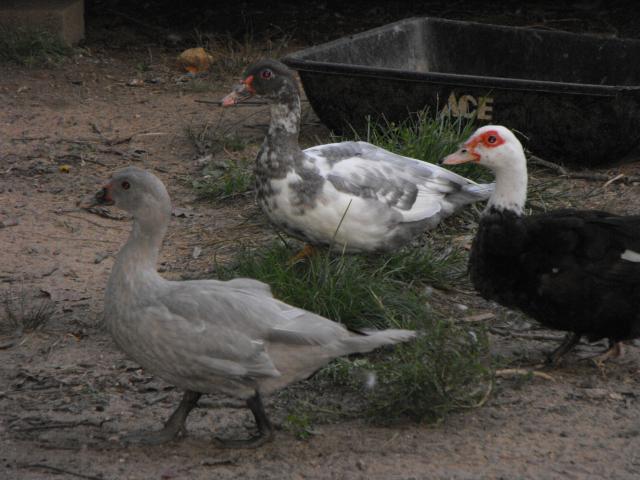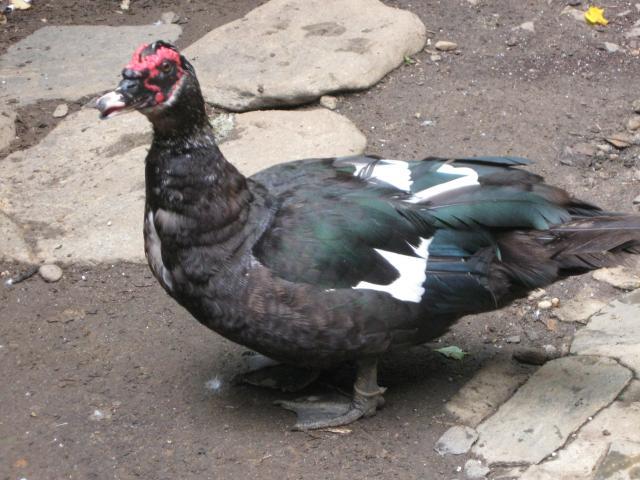Navigation
Install the app
How to install the app on iOS
Follow along with the video below to see how to install our site as a web app on your home screen.
Note: This feature may not be available in some browsers.
More options
You are using an out of date browser. It may not display this or other websites correctly.
You should upgrade or use an alternative browser.
You should upgrade or use an alternative browser.
Who to keep!!!! Muscovy ducks would love input! ETA PICTURES!!!
- Thread starter cukooformarans
- Start date
If the drake that you keep is a carrier for blue, you should get blue ducklings from him and your blue females. That said, you can always keep an eye out for a blue drake. Drakes are a lot easier to come by. Even if you sell your extra drakes without a female you should be able to sell them quickly. As for the barring, yes a lot of the time it is only on the juvenile plumage and they lose it but on some it can still be seen. In those cases it would only be on the belly and thighs. But there is a pattern called ripple that is similar and can be seen on the entire bird. Here is a great link to show all the colors Muscovy ducks come in. http://www.muscovyduckcentral.com/varieties.html
I would keep your favorites. Unless you are planning a breeding program (hone those genetics skills
 ) I think it just depends on your reasons for keeping them. Pets? Meat? Eggs? Ducklings to sell? If pets, eggs or meat, just keep those you like best.
) I think it just depends on your reasons for keeping them. Pets? Meat? Eggs? Ducklings to sell? If pets, eggs or meat, just keep those you like best.

here is a link for a muscovy colour calculator http://kippenjungle.nl/Overzicht.htm?run=muskuscalculator
Last edited:
- Thread starter
- #15
Lol, well the calculator is great ... except ... I can't figure out how to put in a blue fawn drake. (Didn't claim to be very smart ...
 )Is there another way to say that? Thanks so much for everyone's input. We will probably eat or sell some extras, but I mainly wanted muscovies because I love to see pretty babies around the yard.
)Is there another way to say that? Thanks so much for everyone's input. We will probably eat or sell some extras, but I mainly wanted muscovies because I love to see pretty babies around the yard.

two blue hens and one of the black hens (The two blue hens came together and the black hen in this pic came single, so they are not related to the others.

These three hatched from eggs from DipsyDoodleDoo from this site, so they are brothers and sister. Two drakes and one hen. One drake is solid blue fawn, the other drake and the hen have a lot of white with some of the fawn or blue fawn.

(One of the drakes and the hen)

(The more solid drake.)
Another picture of the ducks from DipsyDoodleDoo, EXCEPT the chocolate pied in the middle is the oldest hen I have. She is probably 3 1/2 years old and not related to any of the others.

These 3 came from the same lady and are full brothers and sisters. There are 3 drakes and 1 hen. One of the drakes is the one I had pictured as my favorite. He even stands out in this pic.) I couldn't get a good pic of the third drake of this group, but he looks pretty similar to the other one that is not my favorite. However, all three are pretty, healthy and big. The favorite grew faster and has a lot more barring than the other two, but all three of the drakes have some. The hen out of this group is the first we have ever had to have angel wing. It was an issue with too much protein, which we learned about too late.

So, what do you think?


two blue hens and one of the black hens (The two blue hens came together and the black hen in this pic came single, so they are not related to the others.

These three hatched from eggs from DipsyDoodleDoo from this site, so they are brothers and sister. Two drakes and one hen. One drake is solid blue fawn, the other drake and the hen have a lot of white with some of the fawn or blue fawn.

(One of the drakes and the hen)

(The more solid drake.)
Another picture of the ducks from DipsyDoodleDoo, EXCEPT the chocolate pied in the middle is the oldest hen I have. She is probably 3 1/2 years old and not related to any of the others.

These 3 came from the same lady and are full brothers and sisters. There are 3 drakes and 1 hen. One of the drakes is the one I had pictured as my favorite. He even stands out in this pic.) I couldn't get a good pic of the third drake of this group, but he looks pretty similar to the other one that is not my favorite. However, all three are pretty, healthy and big. The favorite grew faster and has a lot more barring than the other two, but all three of the drakes have some. The hen out of this group is the first we have ever had to have angel wing. It was an issue with too much protein, which we learned about too late.

So, what do you think?
you'll see from the calculator that blue isnt a recessive gene, its a dilution of black. theres some info on blue fawn on this site, good for some genetic help http://www.muscovyduckcentral.com/genetics.html , beware though, once you have the knowledge muscovies get even more addictive the solid coloured
the solid coloured
"blue" in your top pic is "silver". i like the colour of your ducks,we dont have the pastel and chocolate colours here(australia). our brown birds are "bronze" which is the sepia gene.
 the solid coloured
the solid coloured "blue" in your top pic is "silver". i like the colour of your ducks,we dont have the pastel and chocolate colours here(australia). our brown birds are "bronze" which is the sepia gene.
Last edited:
- Thread starter
- #17
Thanks, Ian! I wondered about the sepia color. It looks really pretty, too! Too bad we can't exchange eggs!! (But I think shipping to a different country would be a tad difficult.
 At any rate, you and your site taught me two things. I now know what silver looks like and, if I am reading correctly, another name for blue fawn is lilac. The color calculator is exciting, too!!
At any rate, you and your site taught me two things. I now know what silver looks like and, if I am reading correctly, another name for blue fawn is lilac. The color calculator is exciting, too!!
 Thanks again!!
Thanks again!!


Nice ducks!


well heres mine, kinda boring colors after all the different colors they come in but their mine and I love them...






also wondering if anyone can tell me what kind of duck the red one is in the next picture eating the mealworms with everyone else..








also wondering if anyone can tell me what kind of duck the red one is in the next picture eating the mealworms with everyone else..


Last edited:
Similar threads
- Replies
- 3
- Views
- 1K
New posts New threads Active threads
-
Latest threads
-
-
Impacted crop…. AGAIN!
- Started by Hen_House04
- Replies: 0
-
Brown Leghorn Pullets and Cockerels for sale. Greensburg, Kentucky
- Started by Happy Hens Hatchery
- Replies: 0
-
-
-
Threads with more replies in the last 15 days
-
-
-
Chicken Butt Emergency ‼️ Please Help!
- Started by urlocalcrazychickenlady
- Replies: 71
-
Open Contest BYC Poultry Caption Contest 11-28-25 Pic by Ponypoor
- Started by TwoCrows
- Replies: 55
-
-
×


